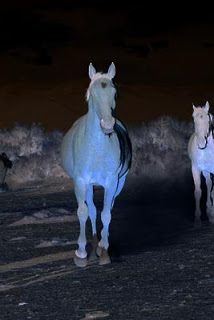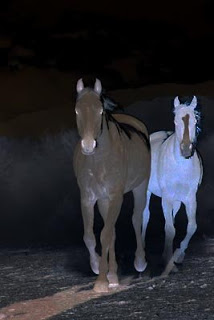
August 13 2019
by Merri Melde-Endurance.net
If you've got a 100-mile endurance ride on your bucket list, but it's worry about riding in the dark that's holding you back, don't be troubled. There are a number of things you can do to make you feel more comfortable while riding in the dark, though sometimes we tend to overthink, and make things more difficult than they really are.
The best thing you can do to make riding in the dark easier is: become a better horseman. (You should always be working on this.) As you learn better communication with your horse, as you learn more balanced and centered riding, you become a better rider and a better partner, and with that comes trust, and with that, you can tackle anything with more confidence.
According to an Equus Magazine article, "Horses have excellent night vision, and on a night lit by a partial moon or by bright stars alone, normally sighted horses can see as well as you do in full daylight.
"The extreme darkness of dense woods and those rare pitch-black nights isn't entirely suitable for riding, but in familiar territory your horse can navigate well enough when you allow him to choose his own path."
I talked to several experienced endurance riders who have riding in the dark down to a science whose advice can help put your mind at ease.
Heather and Jeremy Reynolds are long-time national and international endurance riders. Heather has over 22,000 AERC miles, 50 AERC 100-mile completions, and 3 Tevis Cup wins. Jeremy has over 14,000 AERC miles, 31 AERC 100-mile completions, and 3 Tevis Cup wins.
They both always ride with a headlamp in 100-mile rides. Competing at night with winning or a Top Ten goal in mind means trotting and cantering in the dark; they ride with a headlamp on. They normally don't bother with glowsticks taped to breast collars, because those won't help much in a situation where you're moving along at a fast clip. Heather says, "Unless you’re going 6 miles an hour or less, you’re going to ride faster than the light is projecting. Same with a red headlamp.
"If there’s a full moon and it’s casting a shadow, that’s awesome. Then don’t ride with a light. You can canter along with a bright moon. But if the trail's going to be technical and it’s going to be really dark, we just ride with a headlamp. It’s just safer.
"Also then you’ll know, is the horse slowing down because it just doesn’t want to continue at this pace, or because there’s a hazard in the trail."
If you do choose to ride with a headlamp, the Reynolds recommend turning it on before it gets dark all the way, as sometimes a horse will freak out when you suddenly turn it on in the darkness - not from the light itself but from the shadows thrown by the horse's head.
A horse having pre-ridden a trail will remember it. Heather recounted riding French Open, the 2018 Tevis Cup winner, over the last few miles to the Auburn finish line in the pure dark. "I turned my headlight off, and I was going at a very fast pace, but no one could see where I was. But that was towards the end of the ride. The horse knew exactly where he was; he knew every foot of that trail because that’s where he trained.
"So you can move out in the dark; it’s just easier, as far as your expectations, if you’re aware of and can see what you’re asking the horse to do."
You should be careful and respectful of others if you do ride with a headlamp. "It does bother some people," Heather said. Riding up from behind someone who's not using a headlamp can cast weird shadows, and while turning a light on and off doesn't bother a horse, the shadows can bother some. Simply be polite and courteous, and turn your headlamp off when you get close to another horse, and turn it back on when you pass them. You'll appreciate it when someone does that for you.
Some have said that horses need 20 minutes to adjust to the changes in light, but the Reynolds have not found this to be true (they have put this to the test in training.) "You can turn on your light, then turn it off the next minute, and the horse just keeps right on marching, doesn’t bobble or trip or anything."
Heather's best advice? "Just practice riding in the dark. Try it at home when you’re fresh, and not tired. That magnifies everything when you’re tired at mile 90 and you’re dehydrated and loopy already!"
Meg Sleeper, top USA and international endurance rider with over 15,000 AERC miles and 74 100-mile completions, just rode in Australia for the first time in July, completing the iconic Tom Quilty. Like most 100-mile rides in Australia and New Zealand, this one started at midnight. Why? "Because it's so much fun starting in the dark on a fresh horse," Aussie endurance rider Linda Tanian joked. But seriously. "It is about utilising cooler weather conditions, tradition, [and] getting finished in daylight if possible," she said, "as it can be mentally tougher going into the dark when both rider and horse are getting tired."
Many riders wore headlamps that were brighter than any Meg had ever seen. "At the start," she said, "it felt like you were going on a street with headlights. It was crazy how bright it was. Of course if they turned to look at you, it was blinding." Despite unfamiliarity with both the trail and the horse she was riding, and despite the fact she'd be doing more than half the mileage in the dark, Meg stuck to what she usually does: she wore a headlamp on her helmet though she left it turned off, and she carried a flashlight in her pocket. "I have a flashlight in my pocket in case I really need to carefully look at markings, like if I think i missed a turn. And I have a headlamp that is bright enough that I have an idea of what the footing is, but it’s not actually very bright.
"I don’t like having a super bright light on, because then I have to remember to turn it off if I look at somebody.
"As long as I have an idea of what the footing is, I feel pretty comfortable with that. And I think so much that the horses are fine. They stay out of their way as much as anything else."
Meg did mention an old Vermont township law that one needs to have lights in front and lights behind if you are riding in the dark. In this case. a glowstick on a breast collar and a glowstick in a horse's tail or on the back of the saddle suffices.
Riding in the dark all comes down to common sense. Don't overthink it. Get to where you trust your horse - be it through riding lessons, auditing or attending training clinics, taking your horse through bomb proofing clinics, or just many more wet saddle pads. Learn to ride very balanced and centered in your saddle for those twisty-turny-uppy-downy trails your horse flies along in the dark. Use glowsticks on your horse's breast collar - though if you're going faster than a fast walk, they are likely more comforting to you than of use to your horse. If you wear a headlamp for when you're moving out, or unsure of the terrain, turn it off when you're approaching other riders. Practice in the dark at home.
And - relax. Your horse will probably know what he's doing and he'll probably see fine to negotiate the trail.
And lastly, simple advice from one more experienced endurance rider, Regina Rose with over 14,000 AERC miles, and 18 100-mile completions, including the Tevis Cup once, and the Big Horn 100 nine times.
"Just ride."


No comments:
Post a Comment